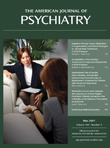The Golden Gate Bridge is the premiere suicide venue in the United States. The lure of the bridge as a place to end one’s life is such that individuals fly long distances to San Francisco, go directly to the bridge, and jump to their deaths. In preparing a talk on suicide prevention, I read about a man in his 30s who left a note in his apartment that said he would not jump from the Golden Gate Bridge if, on the way to the bridge, he met one person who smiled at him. He jumped. I also recalled the story that Nietzsche was dissuaded from committing suicide by a smile from a total stranger.
At the 2006 APA annual meeting, I attended a workshop on bridge suicide. It was sponsored by the Psychiatric Foundation of Northern California, an advocacy group for placing physical barriers to prevent suicide on the Golden Gate Bridge. At least 1,300 known persons have committed suicide by jumping from the bridge. Only 28 have survived a jump from the bridge since its completion in 1937. The workshop chairperson cited a 26-year follow-up study of 515 individuals who were restrained from jumping from the Golden Gate Bridge. Ninety-four percent were still alive or had died from natural causes 26 years later. He noted that the study provided a strong argument for suicide barriers.
Mr. John Kevin Hines, who said he was one of only two persons to survive a jump from the bridge since 2000, was a presenter at the workshop. Mr. Hines’s description of his profound mental suffering and isolation that preceded his suicide attempt was gripping and emotionally moving. The audience asked many questions.
Mr. Hines described his struggle with a severe bipolar disorder that emerged during his adolescence and worsened over time. Mr. Hines was overwhelmed by paranoid delusions and command auditory hallucinations demanding that he kill himself. Unable to function, he withdrew from college and immediately took a bus to the Golden Gate Bridge. Like many people about to commit suicide, he was ambivalent about dying. He tarried at the bridge railing for about 40 minutes, trying to decide whether to go through with his plan to jump.
A number of people walked by him, oblivious to his anguish, unaware of his life-and-death struggle. Mr. Hines told us that “If someone had smiled and said, ‘Are you okay?’ I know I would have begged them to help me. I would have told them everything and asked for help. I would not have jumped. I just was unable to ask for help myself.” In fact, a foreign tourist did stop and talk with Mr. Hines. She asked him to take her picture, which he did. As she walked away, he felt more than ever that “Nobody really cares.” He jumped. On the way down, he changed his mind. He remembered thinking, “I want to live. Why am I doing this?” It was too late. Severely injured, Mr. Hines was kept afloat by a sea lion until rescuers arrived.
I asked Mr. Hines that if someone had smiled at him when he was on the bridge, given the severity of his mental illness, would it have prevented his suicide attempt? He answered, “Yes, a smile would have most definitely helped in my case. If the smile is genuine and caring, and it looks like the person is approachable, that person could have such an impact on a suicidal person at the moment of desperation. They could well save a life.” I recalled the horror-stricken figure in Edvard Munch’s “The Scream.” One sees indifferent people strolling in the background.
What power does a smile hold for someone intent on suicide? When we smile and say hello to strangers or strangers smile and recognize us, what human transaction takes place? What do we feel in either situation? Is the smile and hello saying, “You are a person just like me; I recognize and respect you”? Are we making a human connection that closes our separateness, even for a moment? Durkheim, in his early study of suicide, identified anomie, or social isolation, and impersonality as contributors to suicide. A smile may puncture the lethal bubble of isolation and aloneness that often precedes suicide. I recall Martin Buber’s “I and Thou,” a respect for the unique being of others. Perhaps a smile may convey the message, “You are a valued person. I respect your being. Live!” I also wonder if, in some instances, a smile stirs veiled, primal memories of a parent’s loving smile. We should not overlook the power of simple human connection contained in a smile, even a smile between strangers. A smile or friendly word may tip the balance toward life, countering an impulsive urge toward a lethal act.
This is not to imply that simply smiling at someone who is at high risk for suicide is all that it will take to save a person’s life. Psychiatrists recognize that many factors, both static and dynamic, ultimately determine the choice that a suicidal individual makes. A smile or a hello, however important and meaningful, must shine on a propitious moment in the person’s ambivalent struggle for life.
Mr. Hines is now gainfully employed as an activities coordinator at a high school. He is a frequent speaker at high schools and other interested groups about his experience with mental illness and suicide. Mr. Hines is a strong advocate for physical barriers on the Golden Gate Bridge and other bridges. It is his contention that suicides are impulsive, overcoming the ambivalence about dying that is present to the last moment.
Psychiatrists routinely treat suicidal patients who feel alone and frightened. Powerful messages of kindness, hope, and healing can be conveyed in how we greet our patients. Who can know the beneficence that “little” kindnesses bestow upon our patients and others? For the most desperately ill and hopeless patients, sometimes just a smile and a hello from the psychiatrist can be a human barrier to suicide.

